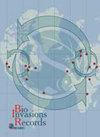Establishment of an invasive snail Melanoides tuberculata (Müller, 1774) in a Sahelian urban reservoir in Ouagadougou, Burkina Faso
IF 1.5
4区 环境科学与生态学
Q3 BIODIVERSITY CONSERVATION
引用次数: 0
Abstract
Human land-use plays an important role in the distribution of aquatic invasive species. The establishment of these species may have an unpredictable impact on their new environment. We analyzed the establishment of M. tuberculata, an invasive species, and its effect on the mollusc community in Ouagadougou’s reservoir No.3. Mollusc samples were collected using an Ekman grab through sampling points randomly distributed across the whole reservoir. Collected specimens were sorted, preserved in alcohol at the field site and transported to the laboratory for identification. Species diversity, abundance and distribution were analyzed. Among the five species encountered, M. tuberculata and L. varicus were identified for the first time in this reservoir. M. tuberculata had the highest relative abundance (60.83%) and the highest density. The evenness was less than 0.5 for 72.5% (i.e. 21) of sampling points, reflecting the relative dominance of a single species, M. tuberculata . In terms of spatial distribution, the most widespread species in the study reservoir was M. tuberculata , followed by C. aegyptiaca and B. unicolor. M. tuberculata distribution in the reservoir mostly overlaps that of B. unicolor (0.45). Renewed monitoring efforts are needed to better understand the evolution of mollusc species in freshwaters of Burkina Faso to understand species extinction risks as well as the potential use of mollusk diversity measures as water quality indicators.在布基纳法索瓦加杜古的萨赫勒城市水库中发现一种侵入性蜗牛结核黑素(m ller, 1774)
人类土地利用在水生入侵物种的分布中起着重要作用。这些物种的建立可能会对它们的新环境产生不可预测的影响。分析了入侵物种结核分枝杆菌(M. tuberculata)在瓦加杜古3号水库的分布及其对软体动物群落的影响。通过随机分布在整个水库的采样点,采用Ekman抓取法采集软体动物样本。收集到的标本进行分类,在现场用酒精保存,并运至实验室进行鉴定。分析了物种多样性、丰度和分布。其中结核分枝杆菌和曲张分枝杆菌为首次在该水库中发现。其中结核分枝杆菌相对丰度最高(60.83%),密度最高。72.5%(21个)采样点的均匀度小于0.5,表明结核分枝杆菌为单一物种的相对优势。在空间分布上,研究库中分布最广的物种是结核分枝杆菌,其次是埃及伊蚊和单色伊蚊。结核分枝杆菌在水库中的分布与单色分枝杆菌的分布基本重合(0.45)。需要重新开展监测工作,以更好地了解布基纳法索淡水中软体动物物种的演变,了解物种灭绝的风险,以及利用软体动物多样性措施作为水质指标的可能性。
本文章由计算机程序翻译,如有差异,请以英文原文为准。
求助全文
约1分钟内获得全文
求助全文
来源期刊

BioInvasions Records
Environmental Science-Ecology
CiteScore
2.90
自引率
14.30%
发文量
58
审稿时长
16 weeks
期刊介绍:
BioInvasions Records is an Open Access, peer-reviewed international journal focusing on field research of biological invasions in aquatic and terrestrial ecosystems from around the world. It was established in November 2011 as a continuation of the former Aquatic Invasions Records, an electronic supplement of the international journal Aquatic Invasions, with start-up funding from the European Commission Seventh Framework Programme for Research and Technological Development Collaborative Project enviroGRIDS.
BioInvasions Records provides authors with their rights protection concerning primary geo-referenced records, biological monitoring and surveys as well as timely publication of reports concerning first alien species records. This contributes to rapid information dissemination, risk assessment procedures and early warning systems on invasive alien species (IAS).
BioInvasions Records may also contribute to timely and coordinated eradication efforts of newly-found IAS. The fast and comprehensive peer review process of manuscripts serves as an effective quality control mechanism.
The journal provides a forum for professionals involved in research and management of invasive alien species, with focus on new records of non-native species.
BioInvasions Records is an official journal of International Association for Open Knowledge on Invasive Alien Species (INVASIVESNET).
 求助内容:
求助内容: 应助结果提醒方式:
应助结果提醒方式:


